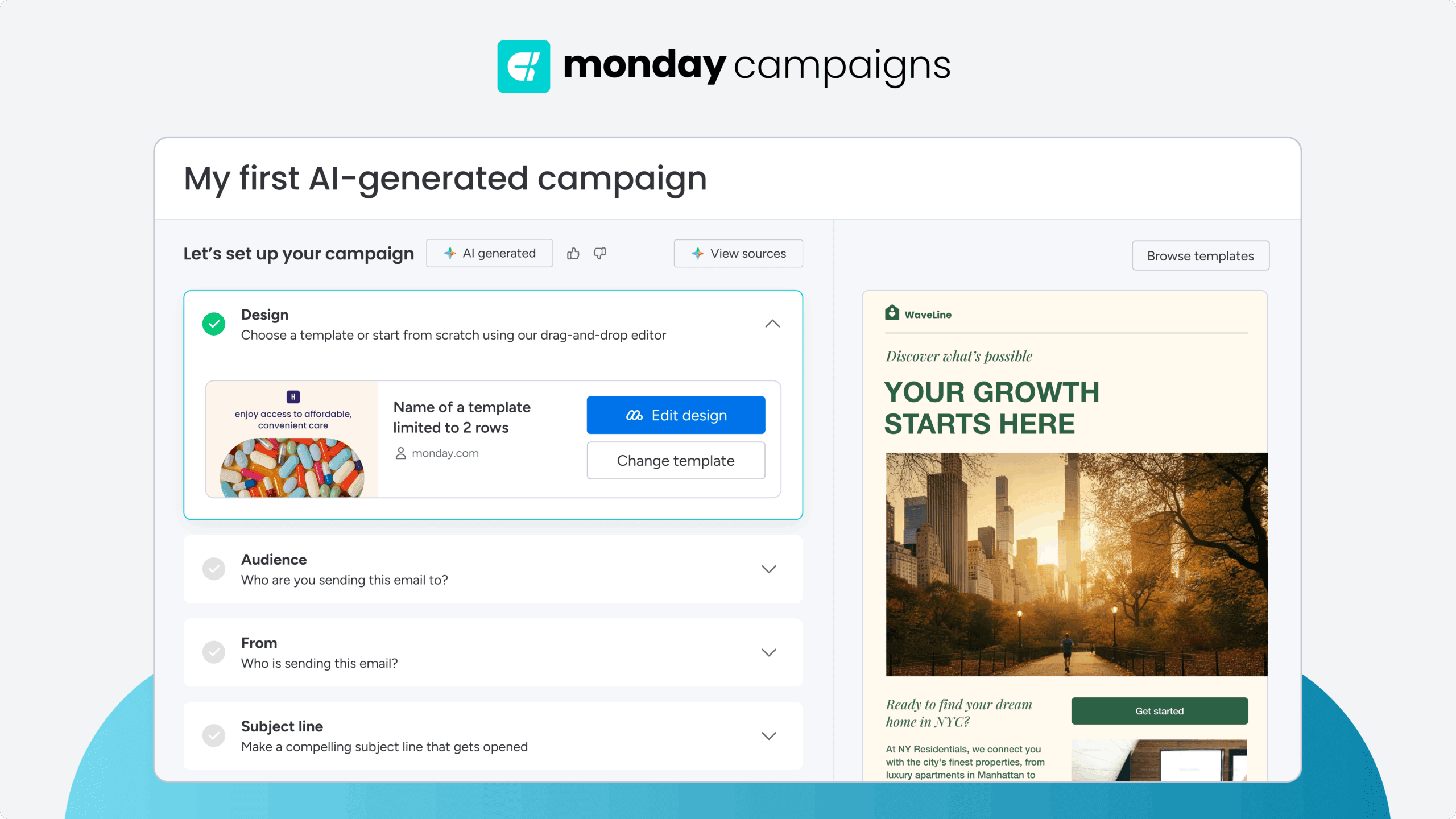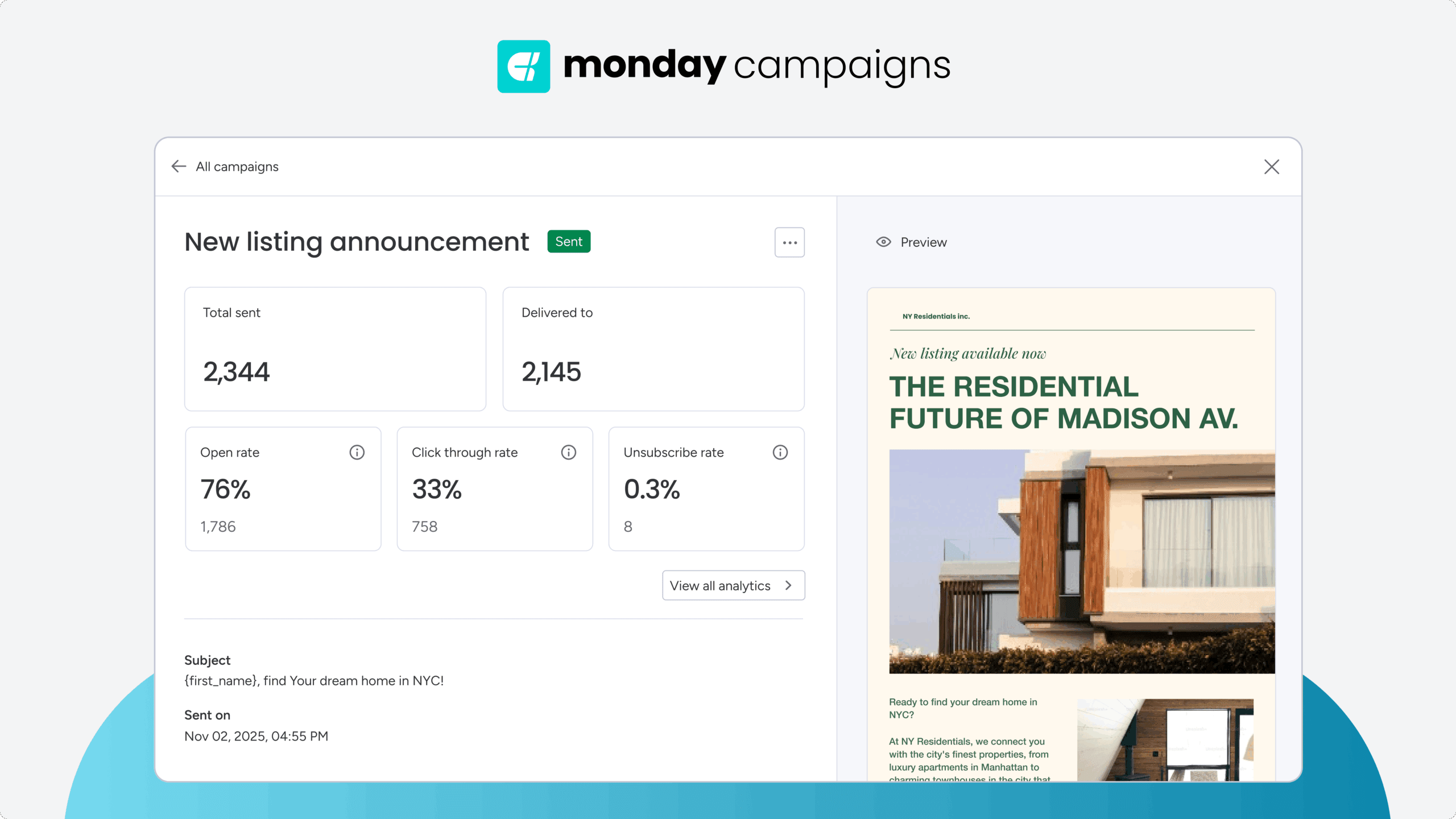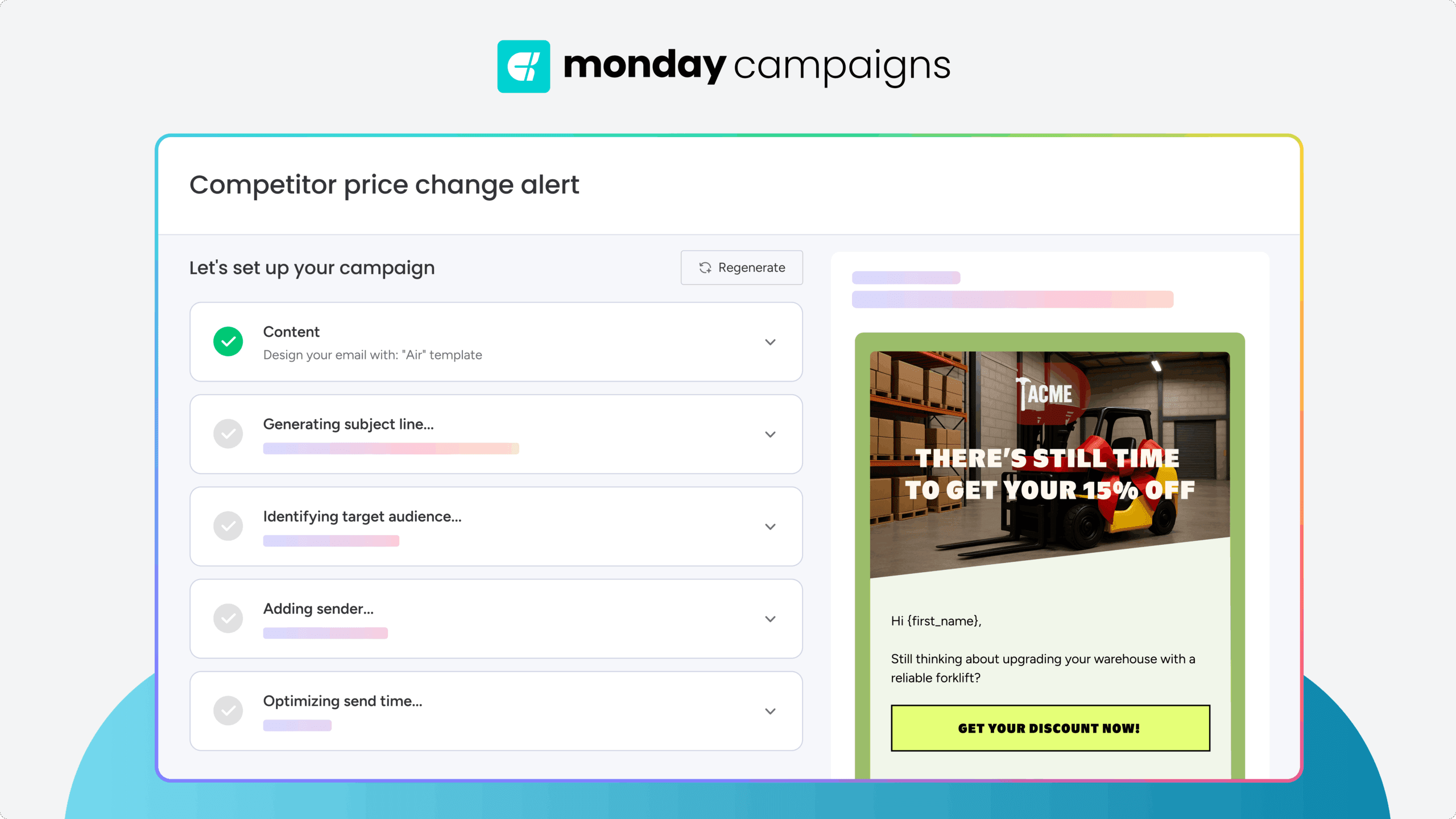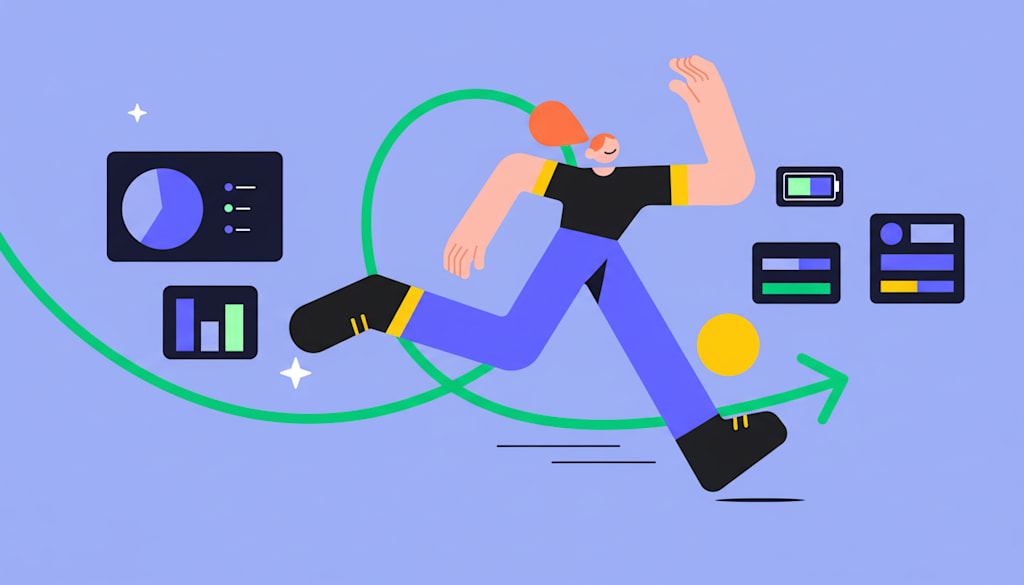For years, marketing success was measured by the next big campaign. A summer sale, a holiday promotion, a product launch. But customers now expect brands to understand their individual needs, not just blast them with generic offers. This fundamental shift from campaign-centric to customer-centric thinking is the core of modern lifecycle marketing.
This guide walks through what effective lifecycle marketing looks like today. We’ll explore the 5 key stages of the customer journey, from initial awareness to loyal advocacy. You’ll also learn how to build a winning strategy, leverage AI for smarter personalization, and avoid common pitfalls that can derail your efforts — plus discover how connecting marketing efforts with sales intelligence helps teams create campaigns that resonate and drive real growth.
Try monday campaignsKey takeaways
- Lifecycle marketing delivers personalized messages based on where customers are in their journey, creating stronger relationships that increase customer lifetime value compared to generic, one-size-fits-all campaigns.
- Each of the 5 critical stages — awareness, engagement, conversion, retention, and advocacy — requires different content and messaging to move customers forward effectively.
- Start by mapping your customer journey and identifying key touchpoints where successful customers differ from those who churn.
- Measure success with metrics that reflect business impact, like customer lifetime value and retention rates, since small improvements in keeping customers create exponential revenue growth over time.
- AI-powered platforms like monday campaigns create optimized campaigns in minutes while connecting marketing and sales data for complete customer visibility and real-time improvements.
What is lifecycle marketing today?
Lifecycle marketing is the practice of creating targeted communications and experiences for customers based on where they are in their relationship with your brand. This means sending different messages to someone discovering your product, which aligns with a marketing funnel, versus someone who’s been a customer for years.
Think of it as having different conversations with people at different stages of knowing you. You wouldn’t talk to a stranger the same way you’d talk to a close friend — and lifecycle marketing applies this same principle to relationship marketing.
The shift from campaign-based to customer-centric marketing
Traditional marketing runs isolated campaigns with start and end dates. You launch a summer sale, measure results, then move to the next campaign without considering the ongoing customer relationship.
Lifecycle marketing changes this by focusing on the entire customer journey. Instead of thinking “what campaign should we run next?” you ask “what does this customer need right now?” This customer-centric model leads to fundamental differences in strategy, execution, and measurement.
Traditional vs. lifecycle marketing
| Traditional campaigns | Lifecycle marketing | |
|---|---|---|
| Approach | One-off promotions with start and end dates | Continuous engagement based on customer behavior |
| Audience | Same message for everyone | Personalized messages by stage and actions |
| Focus | Immediate sales and short-term ROI | Long-term relationships and retention |
| Measurement | Clicks, opens, and conversions | Customer lifetime value and retention growth |
| Tools | Disconnected systems for email, CRM, and analytics | Unified CRM-driven platform like monday campaigns |
Key components of modern lifecycle marketing
Successful lifecycle marketing requires several working parts that connect to create personalized experiences. These components work together to deliver the right message at the right time.
First, you need unified customer data from all touchpoints — website visits, email opens, purchase history, and support tickets. This data creates complete customer profiles that inform every marketing decision.
Next comes automation that triggers personalized messages based on customer actions. When someone downloads a guide, they automatically receive follow-up content. When they make a purchase, they get onboarding emails.
With monday campaigns, teams can automate lifecycle workflows directly within monday CRM — using AI to optimize timing, messaging, and targeting across the entire customer journey.
How lifecycle marketing differs from traditional CRM
CRM systems track customer data and individual sales interactions, while lifecycle marketing turns that data into automated, personalized experiences at scale.
The two aren’t competitors — they’re partners. CRM provides the context (who the customer is, what they’ve done), and lifecycle marketing uses that context to deliver timely, relevant messages automatically.
With monday campaigns, these functions live in the same platform. Marketing teams can use CRM data to trigger AI-powered campaigns the moment a lead moves stages or a deal closes, creating seamless coordination between marketing and sales.
The 5 customer lifecycle stages that matter most
Every customer moves through distinct stages in their relationship with your brand. Understanding these stages helps you deliver relevant messages that match their current needs and mindset.
1. Awareness and discovery
This stage begins when someone realizes they have a problem your product could solve. They’re researching options, reading reviews, and trying to understand their choices.
Customers here consume educational content — blog posts, guides, comparison articles. They want to learn, not buy. Your marketing should help them understand their problem and potential solutions without pushing your product.
Awareness KPI example: % new visitors from target channels, content engagement rate
2. Engagement and nurturing
Interested prospects start interacting with your brand. They download resources, sign up for webinars, or subscribe to your newsletter.
These prospects are evaluating whether you’re the right fit. They want to see how your solution works, what results others have achieved, and whether they can trust your company. Email nurturing sequences, case studies, and product demos work well here.
Engagement KPI example: Lead-to-MQL conversion rate, demo/webinar attendance
3. Conversion and purchase
The prospect is ready to buy but needs final reassurance. They’re comparing pricing, reading testimonials, and looking for guarantees.
Remove barriers to purchase with clear pricing, risk-free trials, and social proof. Make the buying process simple and address common objections before they arise.
Conversion KPI example: Trial-to-paid rate, sales cycle length
4. Retention and growth
New customers need help succeeding with your product. They’re learning features, establishing routines, and evaluating whether they made the right choice.
Focus on onboarding, education, and early wins. Help customers see value quickly through welcome sequences, tutorial content, and proactive support. monday campaigns can automate these touchpoints while personalizing content based on usage patterns.
Retention KPI example: Day-30/day-90 activation, churn rate, product adoption
5. Advocacy and expansion
Satisfied customers become your best marketers. They recommend you to others, leave positive reviews, and consider additional products.
Make it easy for advocates to share their success. Create referral programs, showcase customer stories, and identify expansion opportunities based on their current usage.
Advocacy KPI example: Referral rate, review volume/rating, expansion (upsell/cross-sell) rate
Why leading brands invest in lifecycle marketing
Smart companies recognize that keeping existing customers costs less than finding new ones, with research showing that acquiring a new customer can cost 5 to 25 times more than keeping an existing one.
Lifecycle marketing maximizes the value of every customer relationship while reducing acquisition pressure.
Proven impact on long-term customer growth
When you nurture relationships at every stage, customers stay longer and buy more, which ultimately improves customer lifetime value. Small improvements in retention create exponential revenue growth over time, as studies show that increasing customer retention by just 5% can increase profits by 25% to 95%.
Reduced acquisition costs through enhanced retention
Rising ad costs make retention critical for sustainable growth. When customers receive relevant communications throughout their journey, they’re less likely to leave for competitors.
This improved retention directly reduces acquisition costs. You need fewer new customers to maintain growth when existing ones stick around longer.
Strong alignment between marketing and sales
Lifecycle marketing creates shared visibility into customer behavior. Sales teams see which marketing touchpoints customers engaged with. Marketing teams understand which messages drive conversions.
This alignment eliminates conflicting messages and duplicate efforts. Customers experience consistent communication whether they’re talking to sales or receiving marketing emails.
Because monday campaigns lives inside monday CRM, both teams work from the same customer data — with marketing able to trigger AI-powered flows as sales stages change.
Try monday campaignsHow AI is revolutionizing customer lifecycle marketing

AI makes sophisticated personalization strategies possible at scale. Instead of manually creating segments and writing variations, AI analyzes patterns and optimizes automatically.
- Predictive personalization that works: AI examines customer data to predict what content will resonate, when to send it, and which channel to use. This goes beyond basic rules to consider individual preferences and behaviors. The system learns from every interaction. If customers in similar situations respond well to certain messages, AI applies those insights to future communications.
- Real-time campaign optimization: Traditional optimization happens between campaigns. You analyze results, make changes, then launch again. AI optimizes while campaigns run. Subject lines, send times, and content automatically adjust based on performance. Each customer receives the version most likely to engage them.
- Smarter customer journey mapping: AI reveals the paths customers actually take, not the ones you assume they follow. By analyzing behavior patterns, it identifies the most effective sequences in an inbound marketing funnel and common drop-off points. These insights guide strategic decisions about where to focus resources and which touchpoints need improvement.
5 steps for building a winning lifecycle marketing strategy
Creating effective lifecycle marketing requires a structured process. Follow these steps to build a program that drives real results, ensuring effective marketing project management.
Step 1: Map your complete customer journey
Document every interaction from first touch to loyal advocate. Include marketing touchpoints, sales conversations, support tickets, and product usage.
Involve teams across your organization. Sales knows common objections. Support understands frequent problems. Product tracks feature adoption. Their insights create a complete customer journey map of the customer experience.
Step 2: Identify critical engagement points
Find moments that significantly impact customer decisions. Where do successful customers differ from those who churn? What actions predict long-term value?
These insights reveal where to focus your efforts. If customers who attend onboarding webinars have higher retention, make webinar attendance a priority.
Step 3: Create stage-specific content that converts
Each lifecycle stage requires different content types and messaging approaches. What works for awareness won’t work for retention.
Match your content to customer needs at each stage:
- Awareness: Educational blog posts, industry reports, problem-solution guides
- Engagement: Product demos, comparison guides, customer success stories
- Conversion: Pricing pages, testimonials, free trial offers
- Retention: Onboarding emails, feature tutorials, best practices
- Advocacy: Referral programs, exclusive content, community access
Step 4: Define clear success metrics
Move beyond vanity metrics to measurements that reflect business impact. Customer lifetime value, retention rates, and revenue per customer matter more than open rates, emphasizing the importance of KPI marketing.
Set targets for each lifecycle stage. How many awareness-stage prospects should move to engagement? What percentage of new customers should still be active after 90 days?
Step 5: Test, learn, and scale
Start small with one segment or journey stage. Test different messages, timing, and channels as part of a marketing management process. Once you know what works, expand it to similar audiences.
Regular testing reveals customer preferences and improves performance over time. Document learnings and apply them across your program.
Types of essential lifecycle marketing tools and platforms
The right technology makes lifecycle marketing manageable and effective. Without it, personalization at scale becomes impossible.
Customer data platforms for unified insights
These platforms consolidate customer information from every source — website, email, CRM, support tickets. They create unified profiles that inform all marketing decisions.
Look for real-time data syncing, flexible segmentation, and privacy compliance features. The platform should integrate with your existing systems without requiring technical expertise.
Choose platforms that also prioritize data privacy and compliance with global standards like GDPR and CCPA — transparency builds customer trust at every stage of the journey.
Marketing automation software that scales
Marketing automation platforms execute complex campaigns based on customer behavior. They handle the operational complexity while maintaining personalization.
Essential features include visual workflow builders, multi-channel support, and dynamic content. The platform should grow with your needs without requiring constant reconfiguration.
Analytics platforms for measuring true impact
Understanding which activities drive revenue requires sophisticated analytics. Look for attribution modeling, journey visualization, and predictive capabilities.
These insights guide resource allocation and prove marketing’s impact on business goals. With built-in analytics, monday campaigns connects marketing activities to revenue outcomes.
Try monday campaigns
7 high-converting lifecycle marketing campaigns
These proven campaign types address specific customer needs at each lifecycle stage. Adapt them to your industry and audience for maximum impact, ensuring campaign management stays efficient.
1. Welcome series that build relationships
New subscribers need to understand what they’ve signed up for. A welcome series introduces your brand, sets expectations, and provides immediate value. Space emails over several days to avoid overwhelming new contacts. Include a warm greeting, helpful resources, and clear next steps.
2. Onboarding sequences that drive adoption
Help new customers succeed quickly by sending setup guides, highlighting key features, and celebrating early achievements. Time these messages based on customer actions, not arbitrary schedules. If someone hasn’t completed setup after 3 days, send helpful tips rather than promotional content.
3. Re-engagement campaigns that win back interest
Inactive subscribers aren’t lost causes. You just need to remind them why they signed up and what they’re missing. Try different angles: exclusive content, special offers, or simple check-ins. Sometimes asking, “Are we still a good fit?” works better than discounts.
4. Strategic upsell and cross-sell programs
Existing customers are your best prospects for additional products, because they already trust you and understand your value. Time these campaigns based on usage and success metrics. Wait until customers achieve results with their current product before suggesting additions.
5. Loyalty programs that create champions
Reward customers for continued engagement. Points, tiers, and exclusive benefits give people reasons to stay active, so make participation simple and rewards meaningful. Complex programs with minimal benefits create frustration rather than loyalty.
6. Win-back campaigns for lost customers
Churned customers know your product but chose to leave. Address their specific reasons for leaving rather than sending generic “we miss you” messages. Include product updates that solve previous pain points. Show how you’ve improved since they left.
7. Referral programs that fuel growth
Happy customers will recommend you if you make it easy and worthwhile. Create simple sharing mechanisms and meaningful incentives. Track and celebrate successful referrals. When someone brings in new customers, acknowledge their contribution beyond just rewards.
Common lifecycle marketing challenges and how to solve them
Even experienced marketers face challenges when building lifecycle programs. The key is awareness — knowing common pitfalls upfront helps you design smarter strategies that deliver better results for your customers and business.
Challenge: Treating all customers the same
Generic messages waste opportunities to connect. When everyone gets identical messaging, no one feels valued.
Solution: Segment based on behavior, not just demographics. What customers do tells you more than who they are. Use engagement patterns, purchase history, and lifecycle stage to create relevant groups.
Challenge: Ignoring post-purchase engagement
Many companies focus heavily on acquisition then abandon customers after purchase. This creates churn and misses expansion opportunities.
Solution: Continue nurturing after the sale. Send usage tips, success stories, and educational content. Help customers maximize value from their purchase.
Challenge: Failing to connect marketing and sales data
When teams operate in silos, customers receive conflicting messages. Marketing might promote features sales doesn’t understand. Sales might make promises marketing can’t support.
Solution: Share data and insights between teams. Regular alignment meetings and integrated systems prevent miscommunication. monday campaigns solves this through native CRM integration that keeps everyone on the same page.
How monday campaigns accelerates your lifecycle marketing success
Modern lifecycle marketing demands sophisticated capabilities delivered simply, and monday campaigns provides the intelligence and automation needed without complexity.
AI-powered campaign creation in minutes

Skip the manual work and focus on strategy. Generate on-brand content, identify optimal segments, and determine perfect timing — all powered by AI. The platform learns from your data to make increasingly accurate recommendations. What works for similar customers gets applied automatically to relevant segments.
Native CRM integration for complete customer views

Marketing and sales data live in one place in monday campaigns. See every customer interaction from first touch through ongoing engagement — an integration that enables sophisticated triggering based on sales activities. When deals reach certain stages, a CRM campaign adjusts automatically. Field feedback improves marketing messages in real time.
Real-time optimization based on field intelligence

Sales conversations reveal what resonates with customers, and monday campaigns incorporates these insights to continuously improve marketing messages. Your campaigns evolve based on actual customer feedback, not assumptions, which creates a virtuous cycle where marketing and sales improve together.
Transform your customer relationships starting now
Lifecycle marketing isn’t just about automation — it’s about connection. When every message is timely, relevant, and driven by insight, customers don’t just buy once; they stay, grow, and advocate for your brand.
With monday campaigns, you can bring this vision to life inside monday CRM, turning disconnected campaigns into a single, AI-powered customer journey that evolves with every interaction. Build stronger relationships, prove marketing’s impact, and grow smarter with every touchpoint.
Try monday campaignsFAQs
How quickly can businesses see results from lifecycle marketing?
Regarding how quickly businesses can see results from lifecycle marketing, most see initial improvements in engagement rates within 30-60 days, with significant revenue impact typically visible within 3-6 months of consistent implementation.
What makes lifecycle marketing different from regular email marketing?
Lifecycle marketing delivers personalized messages based on customer behavior and journey stage, while regular email marketing typically sends the same content to all subscribers regardless of their relationship with the brand.
Do small businesses need specialized lifecycle marketing software?
While small businesses can start with basic email platforms, specialized software becomes valuable as customer bases grow and personalization needs increase beyond what manual processes can handle effectively.
How should companies measure lifecycle marketing ROI?
Companies should track customer lifetime value, retention rates, and revenue attribution across lifecycle stages rather than focusing solely on traditional metrics like open rates or click-through rates.
What's the most effective way to begin with lifecycle marketing?
Start by mapping the current customer journey, identifying key touchpoints, and implementing basic automated sequences for new customers before expanding to more complex campaigns across all lifecycle stages.
Can lifecycle marketing work effectively without a large marketing team?
Automation platforms and AI-powered solutions enable small teams to execute sophisticated lifecycle campaigns that would previously require much larger resources and manual effort.
 Get started
Get started 

